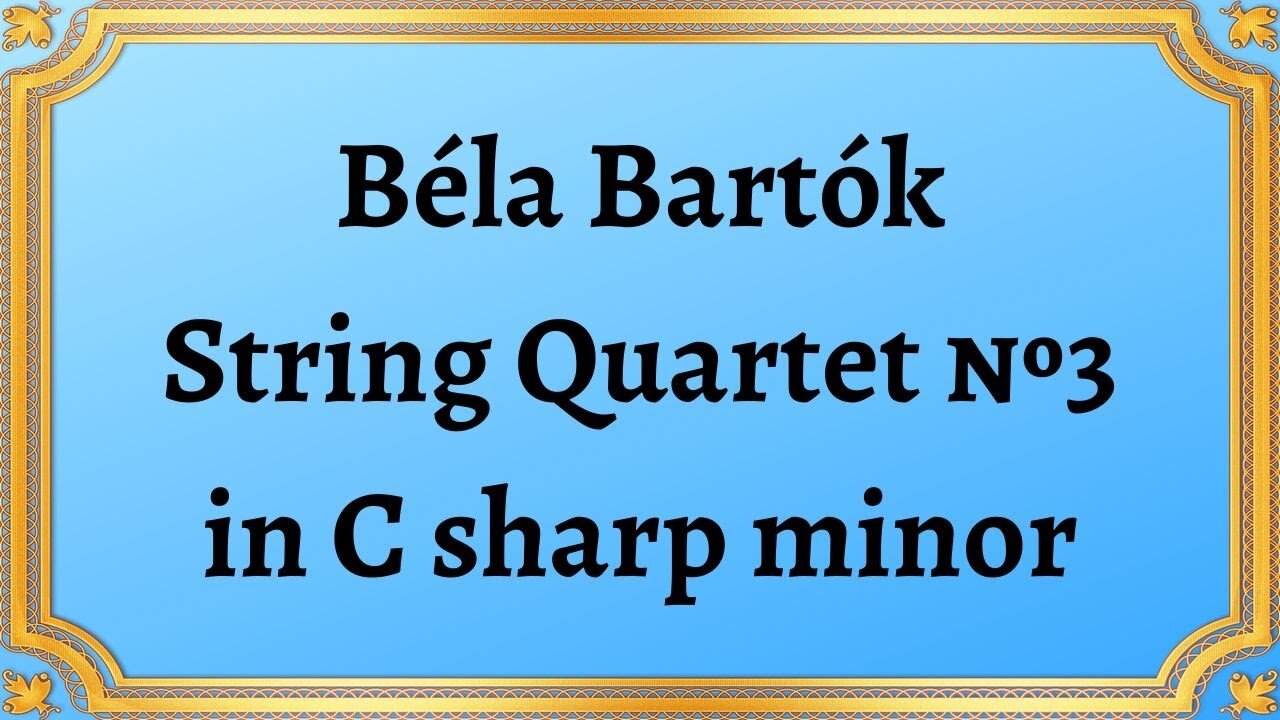Premium Only Content

Béla Bartók String Quartet №3 in C sharp minor
#BélaBartók #StringQuartetNo3 #Csharpminor #classicalmusic #musicalcomposition
Publication date 1950
THE JUILLIARD STRING QUARTET
Robert Mann and Robert Koff, Violins;
Raphael Hillyer, Viola;
Arthur Winograd, ’Cello
Béla Bartók String Quartet No. 3 in C sharp minor is a musical composition that has been recognized by many as one of the most iconic pieces of classical music. The piece is renowned for its complex structure, intricate harmonies, and unique musical language.
The history of Béla Bartók String Quartet No. 3 in C sharp minor dates back to the early 1920s when Béla Bartók was commissioned to compose a piece for the Coolidge Foundation in America. Bartók, who was known for his innovative approach to classical music composition, set out to create a piece that was unlike anything that had been created before. He drew inspiration from his extensive travels throughout Eastern Europe and incorporated elements of folk music into his composition.
The musical elements of Béla Bartók String Quartet No. 3 in C sharp minor are a testament to Bartók's unique style of composition. The piece is structured in five movements, each with its own distinct character. The first movement, marked "Prima parte: Moderato", opens with a haunting melody played by the cello. The second movement, marked "Allegro", is a fast-paced, energetic movement that features intricate interplay between the instruments. The third movement, marked "Recitativo: Fantasia", is a slower, more contemplative movement that features improvisational elements. The fourth movement, marked "Allegro molto", is a lively, rhythmic movement that features a driving ostinato rhythm. The final movement, marked "Finale: Allegro molto", is a frenzied, high-energy movement that brings the piece to a climactic close.
The significance of Béla Bartók String Quartet No. 3 in C sharp minor in the classical music world cannot be overstated. The piece is widely regarded as one of the most important and influential works of the 20th century. Its innovative use of folk music elements, complex harmonies, and intricate rhythmic structures paved the way for a new generation of classical music composers.
In conclusion, Béla Bartók String Quartet No. 3 in C sharp minor is a masterpiece of classical music composition. Its complex harmonies, intricate rhythmic structures, and innovative use of folk music elements make it a timeless piece that continues to influence and inspire classical music composers to this day.
You have the opportunity to support the channel https://destream.net/live/RadSiarAl/donate
-
 24:30
24:30
Classical music_Music Inspiration
8 days agoFranz Schubert Grand Duet for Piano Four Hands, Op. 140
441 -
 1:36:46
1:36:46
RiftTV/Slightly Offensive
2 hours ago $2.95 earnedTrump SHUTS DOWN War with Iran! Bibi IN RAGE | Guest: Joel Webbon | The Rift Report
11.9K4 -
 LIVE
LIVE
Jamie Kennedy
18 hours agoThe Illusion of Time, Portals, and Paranormal Activity | Ep 203 with Jay Wasley of Ghost Adventures
126 watching -
 14:34
14:34
Bearing
9 hours agoUK Transgender Protesters are NUTS 🦄⚧🏳️⚧️
1.86K27 -
 1:41:53
1:41:53
The Quartering
4 hours agoWoke Judges ARRESTED, Rachel Zegler FAILS, McDonalds & Cancer & More
118K66 -
 2:56:07
2:56:07
The Dana Show with Dana Loesch
5 hours agoSEC DEF HEGSETH'S NEW SIGNAL CHAT CONTROVERSY | The Dana Show LIVE on Rumble!
21.3K1 -
 LIVE
LIVE
LFA TV
20 hours agoALL DAY LIVE STREAM - 4/25/25
3,340 watching -
 1:14:15
1:14:15
The Illusion of Consensus
2 days agoMaxime Bernier on Canada's Mass Immigration Crisis
17K -
 1:27:50
1:27:50
Crypto Power Hour
5 hours ago $0.38 earned“Crypto Beyond Currency” w/ Special Guests Evan Mann & Alex Popovic
15.1K4 -
 1:03:45
1:03:45
Jeff Ahern
2 hours ago $0.48 earnedFriday Freak out with Jeff Ahern
15.3K